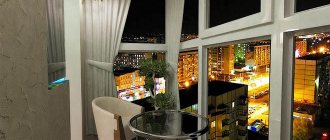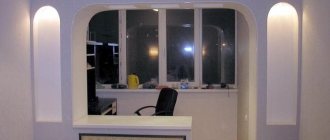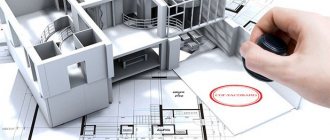In this article we will answer the question of what a balcony and a loggia are, and we will also look at the structural and legislative differences between these structures.
The correct definitions are enshrined in SNiP of 2003, in Appendix B (terms and definitions). According to this document, the difference between a balcony and a loggia is its location in space. It is a platform located outside the front of the house. Can be open or glazed. A loggia is a room built-in or attached to a building. It must be fenced on three or two sides (if it occupies a corner of the building or has an unusual shape).
Simply put, in architectural terms, the difference lies in the location relative to the residential part of the apartment and the number of load-bearing walls. Both of these differences between the designs are clearly visible in the photo.
In modern construction, the appearance of objects can vary greatly. But there are main varieties, which we will discuss further.
Definitions
The difference between a balcony and a loggia is determined primarily by SNiP and GOST standards.
Balcony
Balcony characteristics:
- protrudes from the wall;
- the presence of fences (railings or slabs) is required;
- may have light glazing.
There are also a number of requirements for the balcony in terms of weight (load on the supporting slab) and the presence of heating.
Therefore, with unauthorized reconstruction of a facility (insulation, etc.), problems may arise with regulatory authorities.
Story
Initially, “Balcone” was an Italian defensive structure. Similar platforms with stone fencing were installed above the city gates starting from the 13th century.
A century later, such “decorations” migrated to the facades of private houses.
The French somewhat discredited the essence of the design by using them as toilet rooms. Over time, they stopped relieving themselves on the heads of passers-by, and the “French balconies” became only a decorative element of the building.
Centuries later, the term “French balcony” has almost completely changed its meaning. From a small area fenced with an openwork lattice, it turned into a structure glazed from floor to ceiling.
But such a transformation is inherent only in the countries of the post-Soviet space; in France and Europe it has remained, for the most part, a decorative element.
Kinds
Currently, the emphasis is not on beautiful bas-reliefs and unique decoration, but solely on the functionality of the object. Depending on the shape and design, modern balconies are divided into:
- classical (in the domestic sense);
- with removal along the window sill (increasing space in the middle part);
- with extension along the floor (increasing the width of the slab);
- combined (combination of the two previous options);
Any removal with a width of more than 30 cm must be approved by the relevant authorities. Without permitting documents, such a layout is considered illegal.
- open (without glazing);
- French (fully glazed).
As for the shapes, there are many options: rectangular, round, trapezoidal, triangular, etc. Designers actively bring their own ideas to life, coming up with new options.
Loggia
The main difference between a balcony and a loggia is that the latter does not extend beyond the building. When calculating heating fees, this area is not included in the square footage of the apartment. But the rent (for maintenance of an apartment building) is calculated taking into account the loggia.
Story
Initially, the loggia was structurally different from the balcony. These were two completely different architectural objects.
During the Renaissance, open galleries on the ground floor were called loggias.
They were used for aesthetic purposes. Beautiful arches, statues and paintings on ceilings and walls were an indispensable attribute of ancient loggias.
Such buildings have nothing in common with modern loggias in panel houses. The only thing that now unites these two objects is the open façade.
Kinds
Today there are three types of loggias:
- built- in They are formed by two load-bearing walls of the building on which the floor slab (floor) lies;
- remote _ The structure is formed by walls protruding forward perpendicular to the facade of the house;
- combined (loggias-balconies). This cross has the side walls to match the built-in style and the front railing is pushed forward like a balcony.
A separate type of loggias are corner ones, those that fall on the end of the house. In such structures, one side is glazed, and the second side is the wall of the building.
What is the difference between a balcony and a loggia in an apartment: types of buildings, operating features
First about the balconies. The most common ones are standard ones. They are an open area on a reinforced concrete base. The fence is a grille welded with brackets. In some houses it is replaced by decorative reinforced concrete slabs. They are found in almost all cities of our country.
Types of balconies
- French. They have almost no free space. A semicircular or straight fence covers a small ledge, which is only enough to place your foot. They are mounted not only at doors, but also at windows. Now this is what they call fully glazed buildings.
- Forged. They can be large and small. They can be distinguished by the forged ornament on the grille and base.
- Glazed. Usually these are modern balconies with an expanded area, covered with glass from top to bottom or only half.
- In new buildings there are extensions that half protrude from the house and half are in it.
Differences
Although not everyone understands what the difference is between a balcony and a loggia, there are a lot of differences between these objects.
According to the law, SNiP
The law specifies a number of specific requirements that must be taken into account when constructing apartment buildings:
- SNiP 31-01-2003 - a list of general requirements of building codes;
- GOST 25772-83 - regulates the safety and reliability of railings;
- SNiP 2.01.07 - controls permissible loads;
- GOST 30777-2012 - requirements for glazing (thermal insulation, sound insulation, configuration, etc.);
- GOST R 52749-2007 - concerns installation seams;
- GOST 25697-83 - is responsible for slabs (floors) depending on their type.
All of the above documents apply to both loggias and balconies. But due to the design features of the latter, the requirements for them are more stringent. The main differences relate to the maximum permissible load.
For example, according to the law, only screen-type fencing is allowed for balconies (photo below). Therefore, if you unauthorizedly replace light fencing structures with brickwork (massive slabs, etc.), serious problems will arise with the relevant authorities.
Design
The main visual difference is that the balcony protrudes forward beyond the building, while the loggia does not.
A balcony can be very different from the general design of the building, while a loggia usually acts as a single ensemble with the building.
Number of closed sides
A balcony is an external structure adjacent to the load-bearing wall on only one side.
Even corner objects of this type retain this feature (three sides are open).
The loggia is fenced with monolithic walls on three sides, with the exception of the corner ones. Only two walls can be load-bearing, and the rest can be glazed.
Dimensions (area)
Hypothetically, both of these structures can be of any size and shape, the main thing is that SNiP standards for permissible loads and load-bearing capacity of the object are observed.
In reality, large balconies are found only on the first, or maximum on the second floor. Because only in this case can additional supports be installed to comply with the above standards.
Even standard apartment buildings have differences in the sizes of balconies and loggias. At the same time, the “standard” dimensions change regularly.
| Type of construction | Length | Min. depth | Railing height |
| "Khrushchev" | 2.8–3.1 m | 0.65–0.8 m | 1m |
| "Brezhnevki" (70s) | 2.4 m | 0.65–0.8 m | 1m |
| Panel houses | 3.1 m | 0.7 m | 1.2 m |
| Block houses | 5.64 m | 0.7 m | 1.2 m |
Standard “three-meter” and “six-meter” loggias actually have a length of 3 and 6 m, respectively, with a minimum depth of 0.7 m and a railing height of 1–1.2 m.
In addition, the typical dimensions are influenced by the climatic zone to which the building belongs.
Load bearing capacity
The load-bearing capacity of the balcony slab is taken at the rate of 200 kg per 1 m2. But this is a very conditional indicator. In most cases, this value is calculated individually for each individual apartment. When calculating the load-bearing capacity, many factors are taken into account:
- degree of plate wear;
- location (corner apartment or front);
- presence of glazing;
- wind load;
- type of house (panel, brick, block, etc.);
- amount of possible precipitation.
Taking all factors into account, the reference 200 kg per 1 m2 can be reduced by 50–80%.
Loggias have twice the load-bearing capacity. But when calculating the permissible weight of glazing (insulation, screeds, etc.), you need to leave a gap for the weight of people, furniture, things, etc. And this is a total of at least 300–500 kg.
Area calculation
The calculation of area does not depend on the type of structure, but on its shape. The photo below shows formulas for calculating the area of the most common shapes.
The dimensions of L-shaped loggias and balconies are calculated as the sum of two rectangles. For designs of oval and semicircular shapes, the radius of curvature must be taken into account, so formulas are selected individually.
Price
The final cost directly depends on the area of the structure and the selected materials. But all other things being equal, repairing a balcony (as well as building from scratch) will cost more than reconstructing a similar loggia.
This is due to the fact that in addition to the facade, you will have to spend money on upgrading the side walls. And when calculating the cost of PVC windows, such designs include quite expensive extensions, rotary connectors, etc.
The same applies to the cost of apartments. A living space with a loggia will cost more than a similar apartment with a balcony.
Functionality
In terms of functionality, a loggia is better than a balcony. It is warmer and more closed. In such a space you can arrange a separate office, mini-gym or winter garden.
Hypothetically, due to the loggia, you can even expand the area of the apartment by increasing the square footage of the adjacent room. But in this case, you must first obtain permission from the relevant authorities for redevelopment.
A balcony is only suitable for creating a relaxation area or an open terrace for summer dining. The small load-bearing capacity of the slab significantly limits the possibilities of using this object.
Possibility of arrangement
Minor repairs (painting walls, replacing linoleum, etc.) can be carried out independently. But drastic changes need to begin only after familiarization with the permitting documentation.
Thus, it is impossible to replace a standard parapet with a non-standard one. According to the law, such changes can only be made at the construction stage in the entire high-rise building at once. The developer independently selects a single design, coordinates and approves the project.
Fully folding (frameless) glazing is permitted only when it does not interfere with the appearance of the facade.
In old buildings, it is almost impossible to obtain permission (by legal means) to replace conventional glazing with “French” glazing (from floor to ceiling).
It is also prohibited to take conventional batteries out onto the loggia or balcony. These rooms can only be heated using air conditioners in heating mode.
At the same time, it is worth considering that in large cities the requirements are much stricter than in small ones.
The most stringent standards in the capital. In Moscow, the norms have changed since 2022 (Resolution No. 508, paragraph 10.19). At the moment, collecting a complete package of documents for any redevelopment of a balcony or loggia is almost impossible.
Unauthorized repairs without approval entail thousands of fines and forced return of structures to their original form (at the expense of the violator).
According to SNiP
Loggia is a built-in or attached room, open to the outside space, fenced on three sides by walls (on two sides in case of a corner location) with a depth limited by the requirements of natural light in the room to the outer wall of which it adjoins. May be glazed. (Source SNiP 01/31/2003. Multi-apartment residential buildings, SNiP 02/31/2001. Single-apartment residential buildings).
Balcony is a fenced area protruding from the plane of the facade wall. May be glazed. (Source SNiP 01/31/2003. Residential multi-apartment buildings).
Balcony (from the French balcon, from the Old German balko “beam”) - in architecture, a platform with railings, mounted on beams protruding from the wall. The seats opposite the stage in the middle tiers of the theater are also called a balcony.
A balcony is an unheated room in the form of a fenced area protruding from the plane of the wall of the façade of a building. May be coated and glazed. In the presence of coating and glazing, it has a limited depth, interconnected with the lighting of the room to which it is adjacent. (Source Dubynin N.V. Balcony or loggia? // Housing Construction, No. 7, 2007).
LOGGIA-BALCONY is an unheated room, part of which is built into the building like a loggia, and part protrudes from the plane of the facade wall in the form of a fenced area like a balcony. May be coated and glazed. It has a limited depth, interconnected with the lighting of the room to which it is adjacent. (Source Dubynin N.V. Balcony or loggia? // Housing Construction. - 2007 - No. 7.)
In different houses
Each type of building has its own characteristics, but one cannot say that the differences are too noticeable.
New building
Balconies and loggias in new buildings are wider than in old Khrushchev buildings. As for the length, it all depends on the layout. In large apartments their square footage can reach tens of meters. While loggias and balconies in small studios are miniature.
Panel house
In panel houses, the dimensions of balconies and loggias are tied to the standard dimensions of the slabs. When repairing, you need to pay special attention to seams and joints.
Monolithic house
A feature of a monolithic house is its integrity. The design of the building is such that all facades, loggias and balconies are united by a common system for the redistribution of heat and air.
Because of such development, it is very difficult to insulate a loggia or balcony. The slightest mistake will lead to drafts from the entire high-rise building collecting in the newly insulated structure. Therefore, such work should be trusted only to professionals (even the developer cannot correct the defects).
Typical and modern types of loggias
What is the name of the balcony inside the house? The beautiful word loggia, which has roots in the Italian language (“loggia”).
Part of a room that can be open on one or more sides
Typically there are two sides and a slightly open facade
Semicircular modern building has no sides
Since this is not a remote structure, it can be turned into a full-fledged part of the room or you can make a concrete screed on the floor and place furniture on it. The loggia space is either left open or glazed.
It is easy to insulate such a room
Full connection to residential premises possible
What's better?
The answer to this question depends on the ultimate goals of specific people.
If residents need additional space for an office or gym, it is better to choose an apartment in a new building with a loggia.
Balconies are suitable for lovers of fresh air and open space. After all, it is more convenient to drink coffee in the morning or tea in the evenings on the open terrace.
Is it possible to combine the kitchen with a balcony?
Very often a kitchen is combined with a balcony. What can this do? On the former balcony you can arrange a small dining room, or make it a place for a refrigerator and freezer, that is, food storage.
A bay window-shaped balcony can become a work area for your kitchen
If you combine a loggia with an apartment, the possibilities open up even greater. A popular option today is a study or workshop for a needlewoman. Often the loggia is turned into a kind of hut-reading room, where there is a sleeping place, cozy and pleasant for spending time, bookshelves or a bookcase, pillows, blankets, etc., and, of course, good lighting.
Related article: Prevention for walls using an antifungal agent
Combining a kitchen with a loggia (video)
A balcony and a loggia are two, essentially, different rooms, and one and the other can be combined with an apartment by coordinating your actions with the relevant organizations. With this solution you can give life to your idea, increase the functionality of the apartment and transform it externally.
Good luck!
The best posts
- Socket boxes for drywall: correct selection and installation
- Repair of plasterboard ceilings: we fix the problem ourselves
- Grouting drywall joints: materials and techniques for performing the work
- How to make a partition from plasterboard - step-by-step instructions
- Machine for the production of profiles for plasterboard: production of frame elements
- Decorative plasterboard - for effective decoration of premises
- How to replace drywall - alternative finishing materials
- Door seal: the culprit of drafts, noise and odors
Brief conclusions
For clarity, the main differences are placed in the table.
| Evaluation criterion | Balcony | Loggia |
| External differences | Protrudes from the wall | Hidden in a niche |
| Permissible load | Up to 200 kg per 1 m2 | Up to 400 kg per 1 m2 |
| Possible glazing | Lightweight designs only | Almost all glazing and insulation options are acceptable |
| Functionality | Can only be used for recreation | Many applications |
| Price | Higher | Below |
| Number of closed sides | One | Two or three |
Let there be light!
In addition to fire safety, the absence or presence of a balcony or loggia is influenced by the insolation factor, that is, exposure of surfaces and spaces to direct sunlight. In accordance with sanitary standards, the living room must be illuminated by the sun for at least two hours a day. Typically, developers say that they try to provide at least one loggia or balcony in each apartment. But there are cases when such premises interfere with insolation (most often on the lower floors), so they have to be abandoned.
Today, more and more often, developers offer buyers balconies or loggias with panoramic glazing (that is, on the floor) - this is a positive trend both from an aesthetic point of view and from the point of view of insolation.
Svetlana Denisova, head of sales department of BFA-Development CJSC:
The supply of apartments with large balconies can be considered one of the market trends. Total facade glazing of loggias and balconies made these rooms part of the living space, so there was a need for deeper and larger balconies. In this case, we are talking not only about higher-class apartments. In inexpensive complexes, large balconies are often designed as a standard solution. For example, in the residential complex “Zaliva Ogni” in apartments with an area of 42 sq. m there are huge 17-meter glazed loggias, in which you can place a relaxation area or set up a small winter garden.
Of course, balconies are mostly used as office space rather than as a relaxation area. We live in northern latitudes, our sun is low. A large canopy and deep loggia greatly shade and worsen the lighting conditions inside the rooms. People are quite satisfied with balconies up to 1 meter wide, although terraces also find their consumers.
Olga Zakharova, Director of Sales and Promotion of St. Petersburg Renovation:
The absence of balconies or loggias in modern new buildings is an exception, and such apartments are in much less demand. Today, even the most affordable apartments have balconies or loggias. They are appreciated by buyers and significantly increase the liquidity of the apartment.
Balconies are most often absent in low-rise complexes with a height of 4-5 floors, since fire safety requirements allow this. And in multi-storey buildings, according to fire safety requirements, modern apartments must be equipped with a balcony or loggia. If the height of the building is more than 16 meters, then escape routes must be provided for people in case of fire.
In our residential complexes, almost all apartments have spacious balconies (from 0.9 meters) and loggias (from 3.5 meters). All balconies and loggias in the SPb Renovation apartments are glazed, which increases sound insulation and significantly reduces heat loss. Wide, functional layouts open up scope for ideas for using this part of the apartment.
Marianna Ivleva, head of the group's marketing department:
In our projects, as a rule, each apartment has a balcony or loggia. There are apartments with several balconies or loggias, apartments where access to the balcony is possible from both the kitchen and the living room (residential complex "Kirill and Daria", residential complex "Novoe Sertolovo"), apartments with deep balconies of interesting shapes (residential complex "Kirill and Daria" ", residential complex "Novoye Sertolovo", residential complex "Yasno. Yanino").
In our projects, all balconies or loggias are glazed. This allows you to preserve the architectural appearance of residential complexes, which are built according to individual projects. For example, we used a single stained-glass aluminum glazing to emphasize the laconic classicism of the residential buildings of the New Sertolovo microdistrict. In addition, single glazing allows buyers of our apartments to save money on installing glass-transparent structures themselves, and also additionally saves heat and provides protection from wind, dust and water.
“Loggia” – room
The previous paragraph makes it clear what a loggia is. It is distinguished by:
- number of external walls;
- load bearing capacity;
- sizes.
Often they are a small room (optional with an open wall), which is repurposed into an office, kitchen or nursery. Or they open it up, combining it with the neighboring room - the space increases noticeably. Three internal walls are important - in the loggia this allows you to retain heat. The fourth is insulated with foam plastic, polystyrene or mineral wool.
They are used less and less by analogy with a balcony - it makes no sense to make such a large area a “storage room” if its purpose could be more useful. The total area of the object does not play a role here.
Rice. 4. Option for arranging a loggia
When choosing an apartment with a loggia, you can safely add one more room to the number of rooms. It’s more difficult with a balcony - its functionality is limited. Let's remember what its advantages are: a lot of warmth, light, the opportunity to breathe fresh air while at home, as well as an excellent place to store bicycles, other sports equipment and just for a relaxing holiday.
In modern construction, loggias, due to their functionality, are a priority for architects.
Common Misconceptions
The most common misconceptions are that the loggia:
- The same room as the balcony, there are no differences between them, and their names are synonymous.
- It is an unheated extension. This is not true. It can be connected to the heating system: in some government agencies such rooms - warm and comfortable - serve as a place for employees to rest during their lunch break.
- Cannot have windows in the sides. This is wrong. Modern architectural solutions require the presence of openings in the plane of the walls of buildings.











